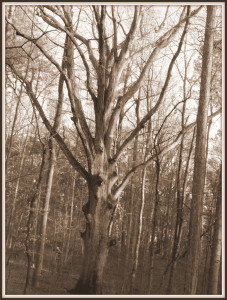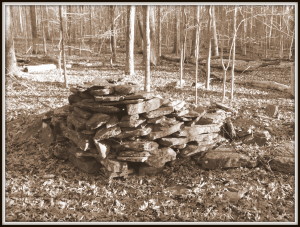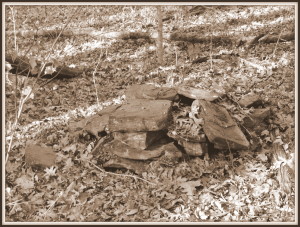A few days ago, my wife and I ventured out to a park we had never hiked in before: Little Mulberry Park in northeastern Gwinnett County, Georgia. After circling Atlanta (I hadn’t the courage to attempt the downtown route) and driving for a near-eternity through the northeast suburbs, we arrived at last at the 890-acre park. The property offers a wide variety of trails, including a number of paved multi-use routes, plus a few for horses, bicycles, and pedestrians, and a couple limited to hikers only. We had only a couple of hours before sundown, so I proposed taking the Gorge Trail loop, a 2.16-mile route through an upland hardwood and pine forest and along the edge of a gorge. I was particularly intrigued to read that the trail included over 200 stone mounds, possibly prehistoric in origin.
Setting out on the trail, we soon came to this stunning old oak tree. Its abundant lower branches attest to a time when it stood alone in a pasture, perhaps as recently as 50 to 75 years ago.

This oak tree, perhaps 150 years old, once grew in a pasture. It now stands in a mixed hardwood forest in Little Mulberry Park, Gwinnett County, GA.
After going up and down several steep hillslopes, we began seeing stone piles everywhere we looked. Some of them were just scatterings of amphibolite gneiss (a metamorphic rock that outcrops throughout the park), while others seemed to be intentionally stacked. Who constructed them, and why were they there?

A stone pile in the forest appears deliberately stacked. But for what reason? Little Mulberry Park, Gwinnett County, GA.
We came to an information sign about the stone mounds, offering an explanation for them and urging visitors to treat them with respect.
The text above asserts that “they are almost certainly associated with native american cultures.” But if archaeologists “have failed to uncover artifacts”, then on what basis was the connection made? How do we know that the mounds are prehistoric in the first place? I will explore this mystery further in my next post. The answers, as far as I can determine them, teach us as much about human nature as they do about the landscape history of the upper Piedmont of Georgia.


More than likely, those piles were not of native american origin, but rather of the colonists. Back before our wonderful Industrial revolution, farmers would plow their fields, and the large rocks that could damage their plows were tossed to the side. They take up less of the valuable farming space when stacked in piles. Stone piles are common all along the east coast where the soil is thick with rock debris, and has not been otherwise developed. The Myth of an Indian graveyard is a far more captivating idea, but the likely hood of finding any artifacts is about the same under such a pile as a piece of ground fifty feet away from it, maybe a little higher as under the pile would not have been tilled by the colonists. -G
Grant, you just summarized quite nicely this trio of posts. In this particular instance, though, no plowing was involved — the land was cleared for pasture, fenced with barbed wire, but never farmed. Stay tuned for the complete story in the next two posts, which will appear in the coming days. By the way, even finding prehistoric artifacts underneath a stone mound would not establish its origin effectively; it would be much more convincing to find such artifacts within the mound.
There are similar piles in Rabbit Hill park.
Randall,
Fascinating. I would not be surprised if they were post-settlement also.
These are almost certainly not field clearing piles. The process of field clearing creates piles with different sized rocks – some piles with big rocks, some piles with small ones. Which is not true here.
Sites like this are common on the East coast but there is nothing similar in Europe (except ancient things). Why would that be true unless it was a different culture over here?
I agree that these are not field clearing piles. The area surrounding some of these piles is quite steep for any agricultural purpose. Why would someone carry these rocks half-way up (or down) a hill to make a pile? If we could only ask Shadrack Bogan (owner of the Hog Mountain House) if the piles where there before he arrived in 1815 or any of the men stationed at Fort Daniel during the War of 1812.
The artifacts are not arrowheads but rock piles.
Not only is Upton one of the finest examples of a beehive chamber, but this chamber is aligned to observe the setting solstice sun and stars of the Pleiades, as marked by large stone piles located on nearby Pratt Hill.
It appears the stones were carefully selected for size and shape and stacked perfectly making sharp corners. It looks like most of the piles have been disturbed through the years but a few maintain their original shape in areas. They are most definetly not piles from agriculture. The fresh water spring down the hill would have attracted native americans to the area and must have been a special place for them. If Pioneers did this I would be surprised. Too much care and skill was used for no apparent reason. Maybe a stone mason practicing or teaching the skill? Maybe. Ive hunted native american artifacts since the 1970s and this has all the signs to me.
There are a bunch of piles, and a defunct dam, in the undeveloped land across Mineral Springs Rd. Next time I take the dog for a walk back there I’ll take some pictures.
I still have two similar piles of rocks in my backyard in Lawrenceville, They are on a slight hill about 10-20 yards from an active creek that was related to the Flowers family mill. The piles could be from field clearing but there was another short wall that ran about 100 yards parallel to the creek but about 30-40 yards away that was more random and characteristic of field clearing. My piles were carefully constructed with larger flat rocks at the bottom and smaller loose rocks at the top. One theory I had was that they could be hunting blinds since they are perched on a hill and look down into the creek valley. Our backyard is also a thoroughfare for year as they migrate from Alexander Park down to a marsh along Five Forks Trikum road.
deer not year 🙂
It amazes me that there are some that cannot attribute stone architecture to Eastern Native Americans even though we KNOW that advanced agricultural, trading societies existed before being devastated by European diseases. The evidence is piling up lol.